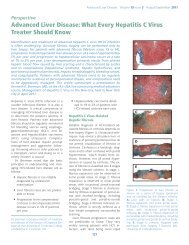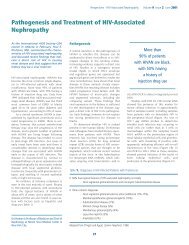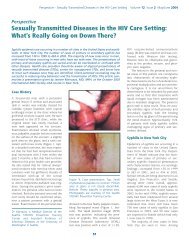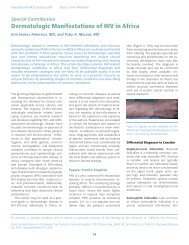Topics in HIV Medicine® - International AIDS Society-USA
Topics in HIV Medicine® - International AIDS Society-USA
Topics in HIV Medicine® - International AIDS Society-USA
Create successful ePaper yourself
Turn your PDF publications into a flip-book with our unique Google optimized e-Paper software.
<strong>International</strong> <strong>AIDS</strong> <strong>Society</strong>–<strong>USA</strong><br />
<strong>Topics</strong> <strong>in</strong> <strong>HIV</strong> Medic<strong>in</strong>e<br />
ed this year, there was consensus that<br />
GBV-C viremia was cleared <strong>in</strong> many <strong>HIV</strong><strong>in</strong>fected<br />
patients (Abstracts 157, 159lb,<br />
and 848) and that early GBV-C viremia<br />
did not predict <strong>HIV</strong> disease progression<br />
(Abstract 157). The precise relationship<br />
between GBV-C and <strong>HIV</strong> rema<strong>in</strong>ed controversial,<br />
however, and more work is<br />
needed <strong>in</strong> this area.<br />
Williams and colleagues reported<br />
that many patients <strong>in</strong> the MACS cohort<br />
cleared GBV-C viremia and became GBV-<br />
C E2 antibody-positive (Abstract 159lb).<br />
Early GBV-C <strong>in</strong>fection was not associated<br />
with <strong>HIV</strong> disease progression, but<br />
patients with susta<strong>in</strong>ed GBV-C viremia<br />
had a survival advantage. Patients who<br />
cleared GBV-C viremia appeared to be at<br />
the highest risk for <strong>HIV</strong> disease progression.<br />
Aboulker and colleagues reported<br />
that GBV-C viremia was associated with<br />
a greater CD4+ cell response <strong>in</strong> early<br />
trials of s<strong>in</strong>gle- and dual-nRTI regimens<br />
(Abstract 849). Xiang et al presented<br />
data from a series of experiments<br />
designed to explore the mechanisms by<br />
which GBV-C could decrease <strong>HIV</strong> replication<br />
(Abstract 156). In an <strong>in</strong> vitro system<br />
<strong>in</strong> which GBV-C-<strong>in</strong>fected cells were challenged<br />
with <strong>HIV</strong>, expression of the CCR5<br />
chemok<strong>in</strong>es RANTES, MIP-1α, MIP-1β,<br />
and SDF-1 were upregulated and were<br />
associated with decreased <strong>HIV</strong> replication<br />
compared with cells not <strong>in</strong>fected<br />
with GBV-C.<br />
In another epidemiologic study from<br />
Sweden, GBV-C viremia at basel<strong>in</strong>e was<br />
not associated with <strong>HIV</strong> disease progression<br />
(Abstract 157). Clearance of GBV-C<br />
viremia occurred <strong>in</strong> 11 of 44 patients<br />
without antibody seroconversion and<br />
was associated with accelerated <strong>HIV</strong> disease<br />
progression. Authors of this report<br />
concluded that GBV-C was secondary to<br />
<strong>HIV</strong> disease progression. In a report<br />
from the Viral Activation Transfusion<br />
Study (VATS), Busch and colleagues<br />
found that GBV-C was transmitted to<br />
22% of <strong>HIV</strong>-<strong>in</strong>fected patients dur<strong>in</strong>g<br />
transfusion (Abstract 846). No cases of<br />
GBV-C viremia occurred among patients<br />
who were antibody-positive prior to<br />
transfusion.<br />
Hepatitis and Liver<br />
Transplantation<br />
In contrast to the 2002 CROI, no new<br />
major hepatitis therapeutic trials were<br />
presented this year. The importance of<br />
<strong>in</strong>clud<strong>in</strong>g detection for hepatitis B virus<br />
(HBV) core antibody <strong>in</strong> screen<strong>in</strong>g strategies<br />
was emphasized by Gandhi <strong>in</strong> a US<br />
study (Abstract 821). In patients <strong>in</strong>fected<br />
with <strong>HIV</strong> and hepatitis C virus (HCV),<br />
history of HBV <strong>in</strong>fection did not produce<br />
a detectable effect on liver histology<br />
(Abstract 822). Tenofovir use was associated<br />
with susta<strong>in</strong>ed responses to HBV<br />
<strong>in</strong> small cohort studies <strong>in</strong>clud<strong>in</strong>g<br />
patients with lamivud<strong>in</strong>e-resistant HBV<br />
(Abstracts 824 and 825). In a large<br />
study of US veterans, Fultz and colleagues<br />
showed that HCV was associated<br />
with reduced survival <strong>in</strong> both the<br />
<strong>HIV</strong>-<strong>in</strong>fected and the <strong>HIV</strong>-un<strong>in</strong>fected<br />
populations (Abstract 828). A second<br />
study of the Veterans Adm<strong>in</strong>istration<br />
population suggested that HCV <strong>in</strong>fection<br />
is associated with an <strong>in</strong>creased risk for<br />
diabetes (Abstract 830). In a Spanish<br />
cohort, more advanced liver fibrosis<br />
(extensive portal fibrosis or cirrhosis)<br />
was more frequent <strong>in</strong> <strong>HIV</strong>- and HCVco<strong>in</strong>fected<br />
patients compared with HCV<strong>in</strong>fected<br />
patients (Abstract 830). In a<br />
small prospective study, patients with<br />
HCV start<strong>in</strong>g HAART showed no evidence<br />
of liver damage due to immune<br />
reconstitution (Abstract 831). Based on<br />
an <strong>in</strong> vitro model, Li suggested that<br />
morph<strong>in</strong>e may enhance HCV replication<br />
(Abstract 158). Kim reported a higher<br />
frequency of CD8+ cell responses to<br />
HCV than previously appreciated<br />
(Abstract 837), and Graham noted Th1<br />
responses were associated with milder<br />
<strong>in</strong>flammation and cirrhosis attributed to<br />
HCV (Abstract 839). A small, descriptive<br />
study of outcome <strong>in</strong> 23 <strong>HIV</strong>-<strong>in</strong>fected<br />
liver transplant recipients suggested<br />
that outcome <strong>in</strong> patients tolerant of<br />
HAART and with CD4+ cell count<br />
greater than 200/µL posttransplant was<br />
similar to that <strong>in</strong> non-<strong>HIV</strong>-<strong>in</strong>fected<br />
patients (Abstract 155).<br />
<strong>HIV</strong> Prevention and<br />
Transmission<br />
In the first plenary session of the conference,<br />
Valdiserri from the CDC gave<br />
an overview of the epidemiology of <strong>HIV</strong><br />
<strong>in</strong>fection <strong>in</strong> the United States (Abstract<br />
4). Estimates of <strong>HIV</strong> cases <strong>in</strong> the United<br />
States have cont<strong>in</strong>ued to rely on data<br />
from 25 states where <strong>HIV</strong> is a reportable<br />
disease. Despite the fact that 2 of the<br />
largest states—New York and<br />
California—are not <strong>in</strong>cluded <strong>in</strong> these<br />
estimates, some important trends were<br />
evident. Among the 25 states, the number<br />
of cases reported <strong>in</strong>creased by 8%<br />
from 1999 to 2001. Valdiserri cautioned<br />
that this <strong>in</strong>crease might reflect a fluctuation<br />
of a steady rate and should not be<br />
over<strong>in</strong>terpreted. More notable, however,<br />
was the consistent and dramatic rise <strong>in</strong><br />
rates of <strong>in</strong>fection among African<br />
American men (15%) over the same<br />
time period.<br />
Behavior and Virus Transmission<br />
An <strong>in</strong>terest<strong>in</strong>g debate among modelers<br />
of the <strong>HIV</strong> epidemic has been around<br />
the effect of HAART on <strong>HIV</strong> transmission.<br />
Although it would seem <strong>in</strong>tuitive<br />
that reduc<strong>in</strong>g <strong>HIV</strong> RNA plasma levels<br />
with HAART would reduce transmission<br />
rates, Valdiserri made the case that<br />
these benefits are lost if wider use of<br />
HAART results <strong>in</strong> an <strong>in</strong>crease <strong>in</strong> highrisk<br />
behavior. He advocated a more<br />
<strong>in</strong>tensive approach to risk reduction<br />
among <strong>HIV</strong>-<strong>in</strong>fected patients receiv<strong>in</strong>g<br />
care through multidiscipl<strong>in</strong>ary cl<strong>in</strong>icbased<br />
programs. Guidel<strong>in</strong>es sponsored<br />
by the CDC and Infectious Diseases<br />
<strong>Society</strong> of America for risk-reduction<br />
counsel<strong>in</strong>g for <strong>HIV</strong>-<strong>in</strong>fected patients <strong>in</strong><br />
care will be released shortly.<br />
It is estimated that at least one quarter<br />
of <strong>HIV</strong>-<strong>in</strong>fected persons <strong>in</strong> the United<br />
States are unaware of their <strong>HIV</strong> serostatus.<br />
Freedberg and others have previously<br />
advocated offer<strong>in</strong>g <strong>HIV</strong> test<strong>in</strong>g to<br />
all hospitalized patients <strong>in</strong> high-prevalence<br />
areas. “Th<strong>in</strong>k <strong>HIV</strong>” was a program<br />
designed by Freedberg’s group to identify<br />
undiagnosed <strong>HIV</strong>-<strong>in</strong>fected patients<br />
<strong>in</strong> Massachusetts present<strong>in</strong>g to urgent<br />
care centers (Abstract 39). Of patients<br />
present<strong>in</strong>g to care <strong>in</strong> a 7-month period,<br />
1853 (31%) accepted <strong>HIV</strong> test<strong>in</strong>g and<br />
37 new <strong>HIV</strong> cases were identified. This<br />
program had a higher yield than selfreferral<br />
test<strong>in</strong>g <strong>in</strong> Massachusetts dur<strong>in</strong>g<br />
the same time period and identified<br />
many patients who did not consider<br />
themselves at risk for <strong>HIV</strong> <strong>in</strong>fection.<br />
Henson and colleagues reported an<br />
update of <strong>HIV</strong> prevalence among<br />
patients present<strong>in</strong>g to the emergency<br />
department at Johns Hopk<strong>in</strong>s University<br />
(Abstract 38). Dur<strong>in</strong>g a 2-month period<br />
90









